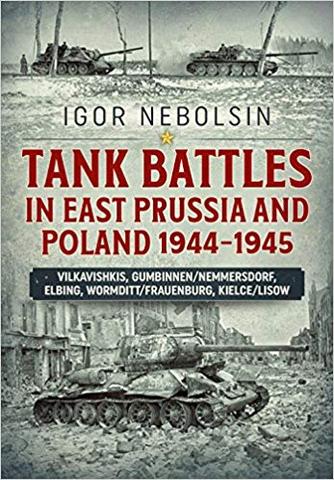Tank Battles In East Prussia And Poland 1944-1945

Igor Nebolsin should be a familiar name for this website's readers, as I have previously reviewed his suberb two-volume combat history of the Soviet 2nd Guards Tank Army. For armored enthusiasts he has done it again - in this massive, well-sourced, and in-depth look into several little known or poorly understood but large Eastern Front tank battles that took place during the Second World War's final year. Tank-on-tank combat that mostly dwarfed the scale of armored clashes in Western Europe at the same time. Even better, a significant portion of the book provides a nice tie-in for those readers who took my advice from earlier this month and ordered a copy of Douglas Nash's latest work.
That's because Nebolsin spends roughly a third of Tank Battles in East Prussia and Poland 1944-1945, covering the armored combat and fighting that occured in the regions surrounding that which the IV-SS Panzerkorps fought during the fall of 1944. Late in 1944 the IV-SS Panzerkorps departed from near Warsaw. Nebolsin's work in part covers events that happened near where the IV-SS Panzerkorps had been operating. Thus, a reader of these two books together will get a much more comprehensive view of the fighting involving most of Germany's Army Group Center and occuring from the period late in 1944 into early 1945. Please note however, this is not a German-centric work. Nebolsin's book hones in on an insider's look as to how the Soviet 2nd Guards Tank Corps, 4th Guards Tank Army, and 5th Guards Tank Army deployed, fought, and defeated their German foes during these months that mostly defined when the Third Reich would fall.
Readers of Nebolsin's work will delight in the coverage of the fighting offered here from the perspective of the "other side of the hill". The German perspective has been availabe for decades. Nebolsin brings much needed balance to the historiography regarding this part of the war. In doing so he puts the respective combat performance of the two combatants in better light. Though I enjoyed the entire book, I found myself even more attentively engaged by the chapters involving the combat experienced by the 2nd Guards Tank Corps and 4th Guards Tank Army. This is because the reader in regards to these chapters will learn how much both of these powerful formations were far more than the collection of men and machines they are typically portrayed as, but instead truly elite combat units. During 1944-1945 both Soviet units faced off against and defeated some of Germany's best armored formations - not least of which being Panzer-Grenadier Division Grossdeutschland and XXIV Panzer Korps.
To this end, I think any reader will be fascinated to learn exactly how in January of 1945 certain elements of the 4th Guards Tank Army that were equipped solely with T-34/85 tanks (note that the 4th Guards Tank Army was equipped with T-34, IS-2, and Lend-Lease M4 Sherman tanks) defeated an entire German heavy tank battalion. Moreover, this heavy German tank battalion was equipped above and beyond its table of organization and equipment with not just Tiger I but Tiger II tanks! Furthermore, almost all of these massive German tanks were fully operational and participated in the battle during which they were destroyed by T-34/85 equipped tankers from the 4th Guards Tank Army. And before you say that's impossible, I say look again. Nebolsin did his homework here. He mines both German and Soviet sources to better establish what must be regarded as the worst defeat suffered by a German heavy tank battalion in World War II.
In fact, the January 1945 meeting engagement between the XXIV Panzer Korps and 4th Guards Tank Army, on paper at least, should have been a mortal threat to the 4th Guards Tank Army's existence. This was true if for no other reason than how well-equipped the XXIV Panzer Korps was in January of 1945 and what had happened in those few instances previously during the war when a rested and properly staffed German panzer korps had met a Soviet tank army in a largely one-to-one fight. But instead, and in a wonderful look at why qualitative factors were truly the most important determinants in the Second World War's outcome - Chapter Three readers of Tank Battles in East Prussia and Poland will see how it was the 4th Guards Tank Army not only defeated, but routed the XXIV Panzer Korps (and did so in a matter of days). All told, the 4th Guards Tank Army gave more than as good as it got - and not just in terms of controlling the battlefield while decimating and driving off Army Group Center's operational reserves. One also has to consider here the fact that irrecovable tank losses were, by the end of the battle, largely on a 1:1 ratio. This in a war in which the Germans otherwise regularly held as much as a 4:1 or higher advantage in terms of tanks destroyed over their Soviet foes in battles featuring such on-paper evenly matched opponents.
Though I am not a fan of the way Helion chooses to place its maps bunched together in the center of the book (thus requiring the reader to thumb back and forth) they were mostly well done in terms of illustrating the ground covered by the text. In addition, this book features a number of unique photographs specific to the events covered by Nebolsin's scholarship. I have no hesitation recommending Tank Battles in East Prussia and Poland 1944-1945 to my readers, and fans of armored warfare in general.



Post new comment